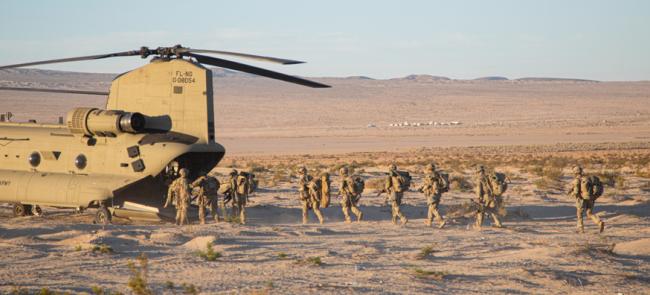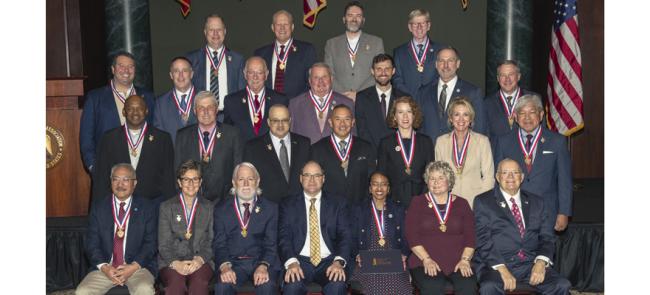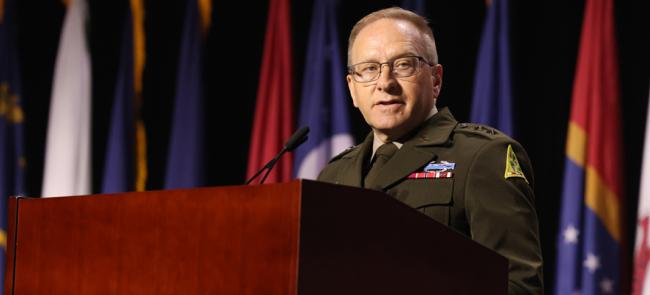
Ticking Clock
Space isn't just the final frontier anymore — it’s critical to everyday life for tens of millions of Americans.
Commerce and communications rely on satellites in space. So does GPS, which is in tens of millions of mobile devices and vehicle navigational systems.
It’s also vital to national security. The U.S. military relies on space-based systems to project power and deter aggression.
None of this surprises the nation’s adversaries, primarily China and Russia, which have their own satellites and anti-satellite capabilities. This makes space a warfighting domain.
The National Guard —mostly Air — has been part of U.S. military space operations for more than 25 years. Approximately 1,500 Guardsmen in seven states and Guam (At a Glance, page 24) supply 100% of the U.S. military’s unit-equipped, surge-to-war operational reserve forces. The Air Guard alone supplies 60% of the nation’s offensive space electronic warfare capability.
Retired Gen. John Hyten, the former vice chairman of the Joint Chiefs of Staff, and Gen. John W. “Jay” Raymond, the head of the Space Force, have said numerous times that the nation cannot accomplish its military space missions without the Guard.
But, currently, the Pentagon has no plans to include Guard space units in the two-year-old Space Force, which has about 8,400 personnel, all full-time, known as guardians.
An April 1 proposal to Congress confirms that position. The Air Force recommended a single component with full-time and part-time positions, no Space Guard or Space Reserve.
The proposal would seem to be the Pentagon’s response to language in the fiscal 2022 National Defense Authorization Act requiring the Defense Department to “conduct a study to determine the appropriate role and organization of space-related assets within the reserve components of the armed forces” by March 31, 2022.
The study was a compromise between the House and Senate over establishing of a Space Guard. The House favored it; the Senate merely wanted to rename the Air Guard the Air and Space National Guard, which would leave things essentially as they are.
All of this means the matter returns to Congress as it begins deliberating a defense policy bill for fiscal 2023.
“There needs to be a sense of urgency,” said Maj. Gen. James R. Camp, Ohio’s assistant adjutant general-Air. “We don’t have time to let our embedded bureaucracy get in the way of making this change.”
At issue is the roller coaster Guard space professionals and their leaders have been on for more than two years. Pentagon officials had finally coalesced around creating a Space Guard when last fall the White House announced it “strongly opposes” the concept.
“Establishing a Space National Guard would not deliver new capabilities,” the Office of Management and Budget said. “It would instead create new government bureaucracy, which the Congressional Budget Office estimates could increase costs by up to $500 million annually.”
Maj. Gen. Daryl Bohac, the adjutant general of Nebraska and president of the Adjutants General Association of the United States, wonders where CBO came up with its estimates.
“It doesn’t take long to look at the footnotes and see it wasn’t informed by any official report from the National Guard Bureau or the Department of the Air Force,” he says. “This led to cost factors that were wildly inflated.”
CBO made two estimates on standing up a Space Guard. The more expensive of the two assumed Space Guard units in all 50 states, three territories and the District of Columbia. Even the lean estimate included a $20 million headquarters NGB says is unnecessary.
Guard leaders say they have never advocated for Space Guard units in each of the 54. They point to a Guard Bureau report that the Space Guard could be created for about $250,000 — the cost to change uniforms and signage.
NGB said the equipment, personnel and facilities already exist.
“The CBO didn’t have the benefit of what the NGB plan or the Department of the Air Force plan was for the creation and absorption of the Space National Guard,” Bohac says.
The White House didn’t either, or it discounted the military’s input.
Meanwhile, the Space Force continues to operate without any semblance of a surge capacity. Guard leaders fear that means the window to create a Space Guard is closing.
There needs to be a sense of urgency.
—Maj. Gen. James R. Camp, Ohio's assistant adjutant general-Air
GUARD SPACE UNITS provide one-of-a-kind space capabilities. In Colorado, four Guard squadrons operate the DoD’s only survivable and endurable missile warning and nuclear detonation detection unit.
The 137th Space Warning Squadron, the 233rd Space Communications Squadron, the 233rd Space Security Squadron and the 233rd Logistics Readiness Squadron oversee the Mobile Ground System.
During a conflict, the MGS moves out to give U.S. leaders incalculable data on potential nuclear missile launches. Its mobility makes it much more difficult to target than a fixed facility.
Space Guard proponents say capabilities like this illustrate why synchronizing active and reserve space personnel is essential.
“The active component simply cannot sustain the operational tempo of global operations without the reserve component,” said Lt. Col. Stephanie Figueroa, the deputy commander of the Colorado Air National Guard’s 233rd Space Group.
“The continued delay of the creation of a reserve component to the USSF widens the chasm between the capabilities the ANG provides and, in turn, limits the capabilities the USSF can provide to combatant commanders — the warfighters,” she adds.
Among the capabilities is operating military satellites, such as the Military Strategic and Tactical Relay, which is the mission of the California Air National Guard’s 148th Space Operations Squadron.
The Milstar satellite constellation provides the national’s senior leaders and military forces reliable and secure communications. During crises like nuclear war, Milstar could be the only link between the White House and the armed services.
“All you have to do is look at the news to see the impact,” says Brig. Gen. Steven J. Butow, the commander of the California Air Guard, while discussing space capabilities like the 148th’s. “This is a 24/7/365 mission.”
China and Russia have made great strides in competing in the space domain. In November, Russia conducted a direct-ascent anti-satellite test, destroying one of its own space objects, a defunct satellite, in low-earth orbit.
In a direct conflict with the U.S., both nations would almost certainly target intelligence satellites, like the ones that have provided imagery exposing Russia’s intentions to invade Ukraine and the atrocities of their forces in the weeks since.
Butow believes the outcome in space will determine the victor of tomorrow’s confrontations.
Guard space units also supply low-cost surge capacity when active-component capabilities are not available. The Colorado Air Guard’s 138th Space Control Squadron, which provides global space electronic attack capabilities, recently deployed a team to support U.S. Africa Command.
“When this force is not being used, it costs on average about 28% when contrasted to its full-time active component force,” Bohac says. “It is a great example of the value of a surge force.”
Guard space professionals also tend to be very experienced, Guard leaders add.
“The Guardsmen who do space missions — because they do it for such a long time — they are recognized as being the best of the best,” said Maj. Gen. Torrence W. Saxe, the adjutant general of Alaska. “They take their skillsets and hone them over a long period of time, and it shows.”
And nearly half of the Guard’s part-time space professionals work full time in civilian aerospace or other high-tech industries, according to NGB.
“We’re talking about a talent pool the Space Force craves,” Butow says. “These are aerospace professionals who in their full-time jobs are at companies like SpaceX, Northrop Grumman and many others.”
Absent a Space Guard, Space Force leaders may try to transfer Guard space units to the new service. The CBO report mentioned this scenario. Few Guard space professionals, especially the part-timers with lucrative private-sector salaries, would likely opt for full-time federal service and move with their units.
“If you lose the talent that exists in the Air National Guard and the space forces that are aligned with the Air National Guard,” Bohac says, “it will take the United States Space Force three, five or even seven years to regain that talent and regrow those capabilities.”
And the nation goes without those capabilities in the interim, he and other Guard leaders say.
“It is imperative that we keep these space professionals and units that are currently doing these space missions operating uninterrupted continuously to help provide for the defense of our country,” said Maj. Gen. John C. Harris Jr., the adjutant general of Ohio.
We're talking about a talent pool the Space Force craves.
—Brig. Gen. Steven J. Butow, the commander of the California Air National Guard
CONGRESS HAS THE LAST SAY in all of this, which is good news for the Guard.
The House already supports establishing a Space Guard, and a bipartisan group of senators recently introduced similar legislation.
Pentagon leaders say Guard space units will continue to train and deploy as needed on space missions. But they will do so “orphaned” from the support that comes from being in the nation’s space service.
“Since space missions have been removed from the USAF, there is no advocate at Headquarters Air Force for the financial resources needed by ANG space units,” Figueroa says.
“Items such as fuel, cold weather gear and chemical, biological and nuclear protective gear have to be funded out of unit funds or requested through many layers of coordination to meet basic mission readiness levels,” she adds.
Training, professional development and career-field management for space forces should also be under one roof, says 2nd Lt. Maria C. Soto of the Colorado Air Guard’s 138th Space Control Squadron.
“It’s having two different sets of core values as two branches of service and having two different methods of PME and leadership development and expecting us to do the same mission,” she says of the current situation.
Saxe says it’s also about aligning cultures, which make a difference both short and long term.
“In the National Guard, be it the Army, the Air Force and hopefully the Space Force, you have to be aligned with a given service,” he explains. “Specifically, if you have people on the same operations floor, one is in the Space Force and one is in the Air Force, you’re going to have a divergence of culture.”
To instill its own culture in recruits, the Space Force in May will begin conducting guardians-only basic training at Joint Base San Antonio, Texas. New guardians had previously gone through initial entry training alongside Air Force airmen.
To understand the consequences of not creating a Space Guard, consider Hawaii’s new space unit, the 293rd Space Control Squadron. The state is having difficulty recruiting qualified candidates to formally stand up the unit due to the lack of clarity on its future.
“The longer we induce this uncertainty about a Space National Guard, we’re slowing down the Space Force’s effort to stand up capabilities,” said Brig. Gen. Joseph R. Harris II, the commander of the Hawaii Air Guard. “Ultimately, that has negative effects for the Space Force.”
The uncertainty is even more palpable in the Guard space units that have been around longer.
“These people have been doing their job and doing it so effectively for so long,” Butow says. “Now’s the time to make that right and make them guardians in the U.S. Space Force.”
Mark Hensch is the NGAUS senior writer/editor. He can be reached at [email protected].
AT A GLANCE
Guard Space Operations
The National Guard has more than 1,000 space professionals in eight states and territories:
● Alaska
● California
● Colorado
● Florida
● Hawaii
● New York
● Ohio
● Guam
Missions include missile warning, space domain awareness, satellite command and control, military satellite communications, space electromagnetic warfare operations, space testing and training, and analyzing space intelligence.
Guard space force also provide:
● 60% of the of the military’s offensive space
electromagnetic warfare
● The only survivable and endurable missile warning
capability
● One of the military’s three upgraded early warning radars
that provide missile warning in defense of U.S. soil
● One of only two ground stations that provide secure
National Command Authority communications
● 100% of the surge capacity
About 45% of part-time space professionals work in civilian aerospace or other high-tech industries.
Source: National Guard Bureau
THE NGAUS TAKE
One poorly informed congressional report appears to be keeping some of the military’s most talented and experienced space professionals out of the Space Force. In June 2020, the Congressional Budget Office said the cost of creating a Space National Guard would run hundreds of millions of dollars. The White House cited the CBO figure in its opposition to the proposal, even though the Pentagon says a Space Guard can be created with existing resources — no new personnel, equipment or facilities. Alternatively, CBO mentioned transferring Guard space units to the purely federal Space Force. Rebuilding these units with new personnel would likely take several years and be very costly. Meanwhile, the nation would go without capabilities defense leaders say are essential to space operations. The matter is now before Congress. Creating a Space Guard is a NGAUS legislative priority.



